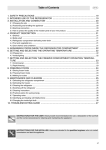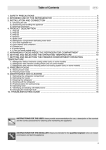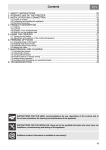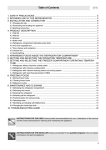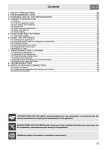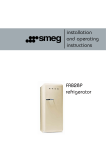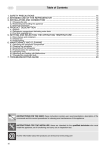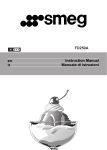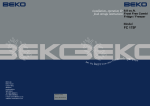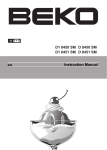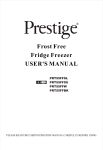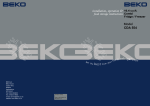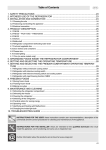Download Smeg FAB40P Owner's Manual
Transcript
Table of Contents 1. SAFETY PRECAUTIONS ...................................................................................................... 19 2. INTENDED USE OF THE REFRIGERATOR ........................................................................ 19 3. INSTALLATION AND CONNECTION ................................................................................... 20 3.1 Choosing the site .......................................................................................................................................... 20 3.2 Positioning and levelling the appliance ......................................................................................................... 20 3.3 Electrical connection ..................................................................................................................................... 20 4. PRODUCT DESCRIPTION ................................................................................................... 21 4.1 Shelves ......................................................................................................................................................... 21 4.2 Fruit and vegetable box ................................................................................................................................. 21 4.3 Door shelves and containers ......................................................................................................................... 21 4.4 Cheese box ................................................................................................................................................... 21 4.5 Inside lighting ................................................................................................................................................ 21 5. DESCRIPTION OF CONTROL PANEL ................................................................................. 22 6. USING THE APPLIANCE ...................................................................................................... 22 6.1 Switching the appliance on ........................................................................................................................... 22 6.2 Arranging foods inside the refrigerator compartment .................................................................................... 22 6.3 Freezing foods .............................................................................................................................................. 23 6.4 Alarm light ..................................................................................................................................................... 24 6.5 Acoustic alarm ............................................................................................................................................... 24 6.6 Storing frozen foods ...................................................................................................................................... 24 6.7 Thawing frozen foods .................................................................................................................................... 25 6.8 Making ice-cubes .......................................................................................................................................... 25 7. MAINTENANCE AND CLEANING ......................................................................................... 26 7.1 Cleaning the refrigerator ............................................................................................................................... 26 7.2 Switching off the refrigerator ......................................................................................................................... 26 7.3 Practical advice for saving energy ................................................................................................................ 26 7.4 Operating noise ............................................................................................................................................. 27 7.5 Identifying and Dealing with Malfunctions ..................................................................................................... 27 7.6 Changing the inside light bulb ....................................................................................................................... 27 8. TROUBLESHOOTING GUIDE .............................................................................................. 28 INSTRUCTIONS FOR THE USER: these provide recommendations for use, a description of the controls and the correct procedures for cleaning and maintaining the appliance INSTRUCTIONS FOR THE INSTALLER: these are intended for the qualified engineer who is to install, commission and test the appliance 17 Safety precautions DISPOSAL INSTRUCTIONS - OUR ENVIRONMENT POLICY Our refrigerators are only packaged using non-pollutant, environment-friendly, recyclable materials. We urge you to cooperate by disposing of the packaging properly. Contact your local dealer or the competent local organisations for the addresses of collection, recycling and disposal facilities. Never leave all or part of the packaging lying around. Packaging parts, and especially plastic bags, may represent a suffocation hazard for children. Your old appliance must also be disposed of properly. Important: deliver the appliance to your local organisation authorised to collect scrapped appliances. Proper disposal allows the intelligent recovery of valuable materials. Refrigeration appliances contain gases which may damage the environment; it is important to ensure that the refrigeration circuit pipelines are not damaged until the competent service has taken delivery of the appliance. Before scrapping your refrigerator it is important to remove doors and leave shelves in position as for use, to ensure that children cannot accidentally become trapped inside during play. Also, cut the power supply lead and remove it and the plug. THIS APPLIANCE IS TAGGED UNDER EUROPEAN DIRECTIVE 2002/96/EC ON WASTE ELECTRICAL AND ELECTRONIC EQUIPMENT (WEEE). THIS DIRECTIVE CONTAINS THE REGULATIONS GOVERNING THE COLLECTION AND RECYCLING OF DECOMMISSIONED APPLIANCES THROUGHOUT THE EUROPEAN UNION. 18 Safety precautions 1. SAFETY PRECAUTIONS Keep the instruction handbook in a safe place; it contains important information which must be applied when installing, using and servicing the refrigerator. The handbook must be kept so that it can be passed on to any subsequent owners of the appliance. The manufacturer declines all responsibility in case of failure to comply with the following precautions: - Do not attempt to operate a damaged appliance: in case of doubt, contact your dealer. - The appliance must be installed and connected to the electrical mains in full compliance with the instructions provided in the handbook. The electrical connection conditions must be as specified on the nameplate, which is in the bottom left-hand corner of the body of the refrigerator. The appliance's electrical safety is only guaranteed if the household electrical system is earthed in accordance with the relevant regulations. - Make sure that all repairs and servicing are only carried out by authorised engineers from the Smeg after-sales service. Always disconnect the appliance from the electrical mains in case of breakdown and maintenance, when changing light-bulbs or during cleaning. Never defrost using electrical devices or steam cleaners. Never remove frost or ice with sharp items, as this may cause irreparable damage to the walls of the refrigerator. - Never attempt to move the refrigerator by pulling on the door or the handle. - High-alcohol drinks must only be stored sealed and vertical. Never store liquids in cans or glass containers in the freezer compartment, especially if they contain added carbon dioxide. Never store products containing gases, flammable propellants or explosive substances in the freezer: explosion hazard! - Do not use electrical equipment (such as ice cream makers or blenders) inside the appliance. - To ensure the refrigerator operates correctly, never obstruct or cover the air ducts in any way. - Never touch frozen products taken straight from the freezer or put them in your mouth. Burn hazard due to the very low temperatures. - Never eat or drink foods which look or smell strange. - Never allow children to play with the refrigeratorand use the drawers, shelves or other parts of the appliance only as described in this handbook; never use them for purposes other than those for which they are designed. In case of electricity blackout, open the door(s) as little as possible. Once partly or completely thawed, frozen foods must not be re-frozen. Caution: this refrigerator contains isobutane (R600a); this refrigerant gas is CFC-free but combustible. When transporting, installing, cleaning and repairing the refrigerator, take care not to damage any parts of the refrigeration circuit to prevent the risk of gas leaks. In case of damage, do not use naked lights and ventilate the room containing the appliance appropriately. 2. INTENDED USE OF THE REFRIGERATOR The appliance is specifically constructed for domestic use and is therefore suitable for the refrigeration and storage of fresh and frozen foods and the production of ice-cubes. The appliance has not been designed or manufactured for professional use. Smeg declines all responsibility for damage deriving from improper use of the appliance. The refrigerator has undergone all necessary tests regarding tightness of the refrigeration circuit and complies with the safety regulations for electrical appliances. Caution: the manufacturer declines all responsibility for injury or damage caused by failure to comply with the above regulations or deriving from tampering with even just one part of the appliance and the use of non-original spare parts. 19 Instructions for the Installer 3. INSTALLATION AND CONNECTION 3.1 Choosing the site Always place the refrigerator in a dry place with satisfactory ventilation. Never expose it to direct sunlight or install it outdoors. Depending on its climate class (stated on the nameplate inside), the wine cellar can be used in different temperature conditions: Class SN (Subnormal) N (Normal) ST (Subtropical) T (Tropical) Ambient temperature from + 10° C to + 32° C from + 16° C to + 32° C from + 18° C to + 38° C from + 18° C to + 43° C Never place the refrigerator close to heat sources. If this is unavoidable, a suitable insulating panel must be used to allow the appliance to function properly. Otherwise, place the appliance at least 3 cm from electric or gas cookers and at least 30 cm from combustion or radiation heating systems. To allow proper cooling of the condenser, the refrigerator must not be placed too close to the wall. To prevent this, the appliance comes complete with two plastic spacers which must be fitted to the top of the appliance as shown in the drawing. If the refrigerator is installed underneath a wall cupboard, the distance between the two must be at least 5 cm. Take care not to scratch or damage the floor when installing the appliance on parquet or linoleum. If necessary, when positioning slide the refrigerator over pieces of wood or a mat to the point decided for connection to the electrical mains. 3.2 Positioning and levelling the appliance Place the refrigerator on a firm, level surface. To compensate for any unevenness in the floor, the appliance has two adjustable feet at the front (fig. 1). The appliance is also equipped with 2 wheels (fig. 2) at the back to stabilise it and make it easier to position. Take care when moving the appliance not to damage the floor (for example, when installing on a parquet floor). 3.3 Electrical connection Before switching the refrigerator on for the first time, leave it vertical for at least two hours. Then connect the appliance's power supply lead to a mains socket with earth contact, installed in accordance with electrical safety regulations. The rated voltage and frequency are stated on the nameplate inside the refrigerator compartment. The appliance must be connected to the electrical mains and earthed in compliance with the relevant regulations and requirements. Check that the voltage rating on the nameplate is the same as the mains supply. If the power supply lead has to be replaced, this operation must only be carried out by an authorised Smeg technical service engineer. The power plug must be accessible after the appliance has been installed. 20 Instructions for the User 4. PRODUCT DESCRIPTION CONTROL PANEL: controls the refrigerator and freezer section temperatures. Freezer compartment (B): compartment for storing frozen foods and for freezing fresh foods. Refrigerator (A): compartment for storing fresh foods. 4.1 Shelves Each refrigerator comes complete with several shelves which can be set at different heights by placing them on the runners provided. Each shelf has a safety fitting to prevent it from being pulled completely out or accidentally removed. To remove it from the appliance, lift it at the back and front and pull it out. Then change the position of the shelf or shelves as you require. For easy removal of all internal accessories, the door has to be opened completely. 4.2 Fruit and vegetable box These containers are at the bottom of the refrigerator compartment, which is fitted with a glass shelf to cover fresh foods that require constant humidity for optimum storage. 4.3 Door shelves and containers The inside of the door is fitted with special shelves and boxes to take eggs, butter, dairy products, tubes, preserves and other small packages. The bottom of the door has a shelf to take vertical bottles. To stop bottles from falling when the door is opened and closed, they must be secured with the special retainer rod supplied. All door shelves and boxes can be removed for cleaning. To remove them from the door, tap them upward with your fist in the first on one side of the insertion zone and then on the other. 4.4 Cheese box A special cheese box with lid is supplied (depending on model). This box can be placed on any shelf as required. 4.5 Inside lighting When the refrigerator door is opened, the light comes on; it remains on until the door is completely closed again. A safety device automatically switches off the light if the door is left open for too long. The same device switches the light on again when it no longer risks overheating. 21 Instructions for the User 5. DESCRIPTION OF CONTROL PANEL 3 REFRIG 4 5 SUPER FREEZER 6 REFRIGERATOR TEMPERATURE CONTROL FREEZER CONTINUOUS OPERATION LIGHT FREEZER TEMPERATURE CONTROL ALARM LIGHT (see par. “6.4 Alarm light”) ACOUSTIC ALARM (refer to point “6.5 Acoustic alarm”) RAPID FREEZING BUTTON (see par. “6.3.1 SUPER function”) ACOUSTIC ALARM OFF (refer to point “6.5 Acoustic alarm”) OPERATING LIGHT 6. USING THE APPLIANCE 6.1 Switching the appliance on After the appliance has been connected to the mains, see par. “3.3 Electrical connection”, turn the knobs and to a position other than the minimum setting. The green light will light up to indicate that the refrigerator and freezer compartments are operating. After starting up the appliance, it will take around 3 hours before the freezer compartment reaches the set temperature. For both compartments, the temperature should be set to reflect how often the doors will be opened, the amount of food stored in them and the ambient conditions. The refrigerator compartment can be set to zero ( ) so that only the freezer compartment is operating. The freezer compartment, however, cannot be set to zero ( ) so that only the refrigerator compartment operates. Important Changes in climatic conditions (temperature and humidity) and the frequency with which the door is opened affect the appliance’s operating temperatures. 6.2 Arranging foods inside the refrigerator compartment Arrange the foods on the various shelves, taking care that they have an airtight wrapping or cover. This precaution will: - conserve foods' fragrance, moisture and freshness; - prevent the cross-contamination of foods with different aromas and tastes; - prevent the humidity level inside the refrigerator becoming too high because of the normal breathing of food (especially fresh fruit and vegetables). In some operating conditions (rise in ambient temperature and humidity, more frequent opening of the door) this might cause condensation to form on the shelves. Use only containers approved for food storage. Always allow hot foods and drinks to cool to room temperature before placing them inside the refrigerator. Never store explosive substances in the appliance and only store high-alcohol drinks firmly sealed and vertical. The NO-FROST system with which the appliance is equipped ensures constant temperature operation and higher cooling power. The air which is fan-driven is free of humidity and quickly dries the food placed in the refrigerator compartment. This is another reason to make sure that the food placed in the refrigerator is sealed. 22 Instructions for the User The dry ventilation air chills the food more quickly; the NO FROST system ensures that the temperature is kept more constant Place the food inside the refrigerator compartment as shown in the drawing 6.2.1 Special meat and fish storage compartment Some delicate foods such as meat, fish and lightly frozen foods can be stored in the special chilled room drawer, in which the temperature is constantly kept at around 0°C. 6.3 Freezing foods For proper storage and freezing, fruit and vegetables should be packed in portions of not more than 1 kg and meat and fish up to a max. of 2 kg. Small packages of food freeze more quickly, giving better conservation of their nutrients and flavour, even after thawing and preparation. Use only freezer bags, aluminium film, food-approved polyethylene film and freezer containers. Do not use paper bags, non food-approved cellophane bags, shopping bags or used freezer bags. Pack foods in airtight packs and try to expel all the air. If using bags, close the packs with the elastic bands or plastic-coated wire strips provided. Always cool hot foods to room temperature before placing them in the freezer and do not allow frozen foods to touch fresh foods for freezing. Always mark packs with the date of freezing, quantity and type of food and make sure that foods are fresh and in good condition. The max. amount of fresh foods which can be frozen in a 24-hour period is marked on the nameplate. Do not exceed the stated amount: this reduces the freezer's efficiency and its ability to preserve the frozen foods it already contains. In case of power failure, the freezer compartment maintains its temperature for around 18 hours. 23 Instructions for the User 6.3.1 SUPER function This function provides rapid freezing and must be activated at least 4 hours before the food is placed in the freezer compartment. To start this function press the button for at least 2 seconds as described in point “5. DESCRIPTION OF CONTROL PANEL”. The yellow light turns on to indicate that the function has been activated. When this function is set the refrigeration system operates continuously and allows rapid freezing of large amounts of fresh foods. Small amounts of fresh foods (up to about 2 kg) can be frozen even without activating the rapid freezing function. To avoid wasting electricity, do not keep this function activated for a long time. The rapid freezing switch should be turned on the first time the freezer is turned on, and whenever it is turned on after a period out of use, to lower the temperature in the relative compartment more quickly. Do not place fresh or frozen foods into the freezer compartment before the alarm light (“6.4 Alarm light”) switches off. The rapid freezing function stays on for around 27 hours, but it can be turned off at any time by holding down button for at least a second, until the light turns off. 6.4 Alarm light The indicator light shown in point “5. DESCRIPTION OF CONTROL PANEL” turns on when the temperature inside the refrigeration cell is too high. The alarm status can also be due to the following causes: - the appliance is connected for the first time or after a long power failure, and it stays on until the freezer compartment has reached a suitable temperature; - the freezer compartment door has been left open for too long, thus losing the cold inside it; - too much food has been placed in the freezer compartment (see nameplate for maximum food quantity); - the temperature set in the freezer compartment is not suitable for the amount of food placed in it; - there is an operating fault. 6.5 Acoustic alarm When the indicator light comes on, the acoustic alarm will be activated as well. To stop the acoustic alarm, press briefly button . If after two hours the alarm is not reset, the acoustic alarm is once again activated. If the acoustic alarm is activated three times in a row, consult chapter “8. Troubleshooting Guide”. 6.5.1 Acoustic alarm “doors not closed” The acoustic alarm is activated when one of the doors or both doors failed to close for more than 3 minutes. To deactivate the acoustic alarm press briefly button or close the doors. 6.6 Storing frozen foods When purchasing frozen foods, always take care that the pack is not damaged, that the product is not past its sell-by date and that the thermometer of the freezer in which the products are displayed for sale does not show a temperature above -18°C. Also note the temperature advice, storage period and modes of consumption stated by the producer. Purchased foods should also be protected using suitable insulated containers during transportation to eliminate the risk of thawing. An increase in temperature might reduce their storage life and adversely affect their quality. Do not purchase frozen foods which have too much frost on them: they may have already been thawed and refrozen. 24 Instructions for the User FOOD 1 Vegetables Fruit Bread - Confectionery Milk Ready-meals Meat: beef veal pork poultry game minced meat Smoked sausage Fish: oily lean Offal 2 3 STORAGE PERIOD (IN MONTHS) 4 5 6 7 8 9 + + 10 + + 11 12 + + + + + + + + + + + + + + + + + + + + + + + + + To prevent deterioration of frozen foods, do not exceed the permitted storage date, which depends on the type of food. 6.7 Thawing frozen foods Partially thawed foods should be eaten as soon as possible. Low temperatures preserve foods but they do not destroy the micro-organisms which are activated after thawing, which may cause the stored foods to deteriorate. If thawed foods smell and look normal, they can be cooked and if required re-frozen once they have cooled. Depending on their type and intended use, frozen foods can be thawed correctly at room temperature, in the refrigerator, in an electric oven (conventional or fan), or in a microwave oven using the relevant function. 6.8 Making ice-cubes Fill the tray provided 2/3 full of water or any other liquid you wish to freeze. Place it in the freezer compartment, making sure that its bottom is dry so that it will not stick to the shelf of the compartment. To detach the ice-cubes, twist the tray slightly or place it under running water for a few seconds. 25 Instructions for the User 7. MAINTENANCE AND CLEANING 7.1 Cleaning the refrigerator Before cleaning, disconnect the plug from the electrical mains. Clean the outside using only water and a gentle liquid detergent or an ordinary detergent for washable surfaces (such as a window-cleaning product). Never use products containing abrasives or substances which may attack the lacquered or painted parts, acids or chemical solvents. Use a sponge or a soft cloth. Do not use steam cleaners to clean the inside; we recommend the use of refrigerator-specific disinfectants. Special SMEG steel cleaning products are available from our Service Centres. Remove the shelves and accessories, taking care not to apply excessive force when removing. Never wash removable plastic parts in the dishwasher; use only warm water and washing-up liquid or water and vinegar. Take care not to wet the electrical lighting components with water or detergents. Clean the gaskets with warm water and then dry. To allow the refrigerator to operate at full efficiency, periodically also clean the condenser on the rear with a brush or a vacuum cleaner( ). Also make a periodic check on the tray above the compressor ( ), and clean it if necessary. When checking the condenser tray, pull out the water drain tube Make sure to replace both the tray and the tube correctly. and check that it is unobstructed. 7.2 Switching off the refrigerator If the refrigerator is to be out of use for some time, turn the thermostat knobs to 0. Then empty the compartments, disconnect the appliance from the electrical mains, and dry any residual moisture which has collected. Leave the door ajar to prevent the humidity and trapped air from creating unpleasant smells. 7.3 Practical advice for saving energy - 26 Install the refrigerator in a cool, well ventilated place, protected against direct sunlight and well away from heat sources; Do not place hot foods in the refrigerator or freezer sections. Wait for foods and drinks to cool to room temperature before placing them on the shelves; Open the door(s) as infrequently and for as short a time as possible to prevent the compartments from warming up too much; Clean the condenser (rear of the refrigerator) periodically to prevent the appliance from losing efficiency; On models equipped with the rapid freezing function, do not leave this function activated for longer than absolutely necessary; If the refrigerator is to be out of use for a long period, it is best to empty it and switch it off; Thaw frozen foods in the body of the refrigerator in order to exploit the cold stored in the frozen foods, which will be transferred to the refrigerator if this procedure is used. Instructions for the User 7.4 Operating noise The refrigerator and freezer are cooled by means of a compression system. In order to maintain the preset temperature inside the refrigerator and freezer sections, the compressor comes into operation in response to the level of cooling required, and may operate continuously if necessary. When the compressor starts up a humming sound will be heard, tending to drop in volume after a few minutes. Another normal refrigerator operating noise is a gurgling due to the coolant flowing through the pipes in the circuit. This noise is perfectly normal and does not mean that the appliance is malfunctioning. If it is over-loud, there may be other causes. In this case, check that: - the refrigerator is properly levelled on the floor and does not vibrate when the compressor is in operation: adjust the feet provided as appropriate; - The drawers, shelves and door boxes are correctly fitted and securely in place: fit correctly; - Bottles and containers on the various shelves are stable and not touching: the vibration due to operation of the compressor may generate some noise; - Do not place kitchen units or other appliances so that they are touching the refrigerator. 7.5 Identifying and Dealing with Malfunctions Your new refrigerator is designed and built to strict quality standards. This section is intended to enable you to identify the origin of any malfunctions which may occur before contacting the Smeg After-Sales Service. 7.6 Changing the inside light bulb Before changing the bulb, make sure that the light has not stopped working simply because the part inside the lamp socket has become loose. In all cases, whether you wish to check that the socket is connected correctly or change the bulb, for safety reasons the plug must be removed from the power socket. Use your fingers to remove the cover (in the direction shown by the arrow) so that it exits from its seat. Replace the lamp with an equivalent one (max. power 25 W). 27 Instructions for the User 8. TROUBLESHOOTING GUIDE PROBLEM Noisy operation The compressor starts up too often or operates continuously: The compressor does not start up: - Refrigerator sufficiently: section not cooled - - POSSIBLE CAUSE compressor and cooling inadequate: condenser - rise in outside temperature; doors opened often or for long periods; too much fresh food placed in the appliance. temperature regulator on 0 (stop); power supply lead not connected to the electrical mains; mains socket not supplying electrical power. inside temperature setting thermostat set too low (1-2) (this corresponds to higher interior temperature); door opened often or for long periods; door not closing properly; rise in outside temperature. - freeze less food at a time; - connect the cable to the power supply; contact the utility company. - Turn the regulator intermediate setting. - open the door less often and for as short a time as possible; check that the foods are arranged on the shelves correctly and are not preventing the door from closing properly, and that the refrigerator is well levelled on the floor; check that the gasket is sealing properly and is not damaged. if you attempt to open a door again just after closing it (especially the freezer door), considerable strength is required. This is because of the vacuum caused by cooling of the warm air that has entered the appliance. - Door hard to open just after closing: 28 PROBABLE SOLUTION see "7.4 Operating noise" check that the rear of the appliance is properly ventilated as explained in par. "3.1 Choosing the site" and that the condenser is not over-dirty; - to an Instructions for the User PROBLEM Temperature inside freezer section not low enough to freeze foods properly: POSSIBLE CAUSE inside temperature setting thermostat set too low; - door opened often or for long periods; door not closing with an airtight seal; - - too much sugar in foods for freezing. Too much condensation forming in refrigerator section: check that the door gaskets are providing an airtight seal on the refrigerator; - door opened often or for long periods; - too much fresh food (fruit and vegetables) placed on the shelves; Foods not properly covered or stored in airtight containers. cooling temperature regulator device set too high (meaning lower temperature inside the appliance). - Temperature inside refrigerator section too cold - fresh foods are freezing: - PROBABLE SOLUTION Turn the regulator to an intermediate setting. If the red light is on, the temperature inside the freezer is higher than that set); open the door less often and for as short a time as possible; check that the foods are arranged on the shelves correctly, that the gasket is sealing properly and is not damaged, and that the refrigerator is well levelled on the floor; some foods can only be completely frozen at very low temperatures (ice-cream, concentrated fruit-juices) In case of cracks, try to soften the gasket by pulling it with one hand and sliding your closed fingers along the inside; open the door less often and for shorter times, especially when the appliance is working in warm, humid conditions; place less food inside the refrigerator section; Cover the containers and seal foods. Turn the regulator to a lower setting. cover foods using suitable bags and containers; do not place fruit and vegetables inside when too wet; do not place foods inside touching the back of the refrigerator. 29 Instructions for the User PROBLEM Too much ice forming in freezer: PROBABLE SOLUTION Use the regulator to set a lower cooling temperature to increase the temperature inside the appliance slightly; - check that the gaskets are providing an airtight seal: if they are cracked, try to soften the gasket by pulling it with one hand and sliding your closed fingers along the inside; - open the door less often and for shorter times; - rise in atmospheric temperature and humidity; - do not place hot food or drinks inside the freezer. Front of cabinet hot to the touch: - the refrigerator is operating normally. Inside the cabinet there is a surface cooling system designed to restrict the formation of condensation in the area where the door gasket closes. Doors out of alignment: - check that the refrigerator is levelled properly, by also adjusting the two rear feet if necessary. Check whether changing the settings of the two feet improves the alignment. AFTER-SALES SERVICE - READING THE NAMEPLATE. IF THE PROBLEMS WITH THE PRODUCT YOU HAVE PURCHASED ARE NOT AMONGST THOSE DESCRIBED ABOVE AND IF YOU NEED MORE INFORMATION, PLEASE CONTACT THE AUTHORISED AFTER-SALES SERVICE. YOU WILL FIND THE ADDRESS AND TELEPHONE IN YOUR LOCAL TELEPHONE DIRECTOR UNDER SMEG. - POSSIBLE CAUSE inside temperature setting thermostat set on too low a temperature. TO SPEED UP THE SERVICE, PLEASE BE READY TO INFORM OUR CALL SERVICE OPERATORS OF THE MODEL OF THE PRODUCT YOU HAVE PURCHASED AND THE SERIAL NUMBER MARKED ON THE NAMEPLATE INSIDE THE BODY OF THE REFRIGERATOR. THANK YOU IN ADVANCE FOR YOUR ASSISTANCE. 30














